Do you want to learn about some of the best rhomboid exercises to include them in your workouts for a stronger, better-looking back?
When it comes to back muscles, the focus is usually all about the lats and traps and even the rear delts.
However, you can’t forget about the rhomboids if you want a well-rounded, strong, and good-looking back.
If you neglect your rhomboids and fail to strengthen them alongside the other muscles in your back, it can lead to poor posture, decreased performance, and even injury down the line.
Strengthening your rhomboids is essential for achieving the best possible physique and will improve your performance.
This blog has detailed descriptions of the following topics:
- What is Rhomboid Muscle
- How to Train Them
- 28 Best Rhomboid Exercises
- Sets and Reps
- Workout Routine
- FAQs
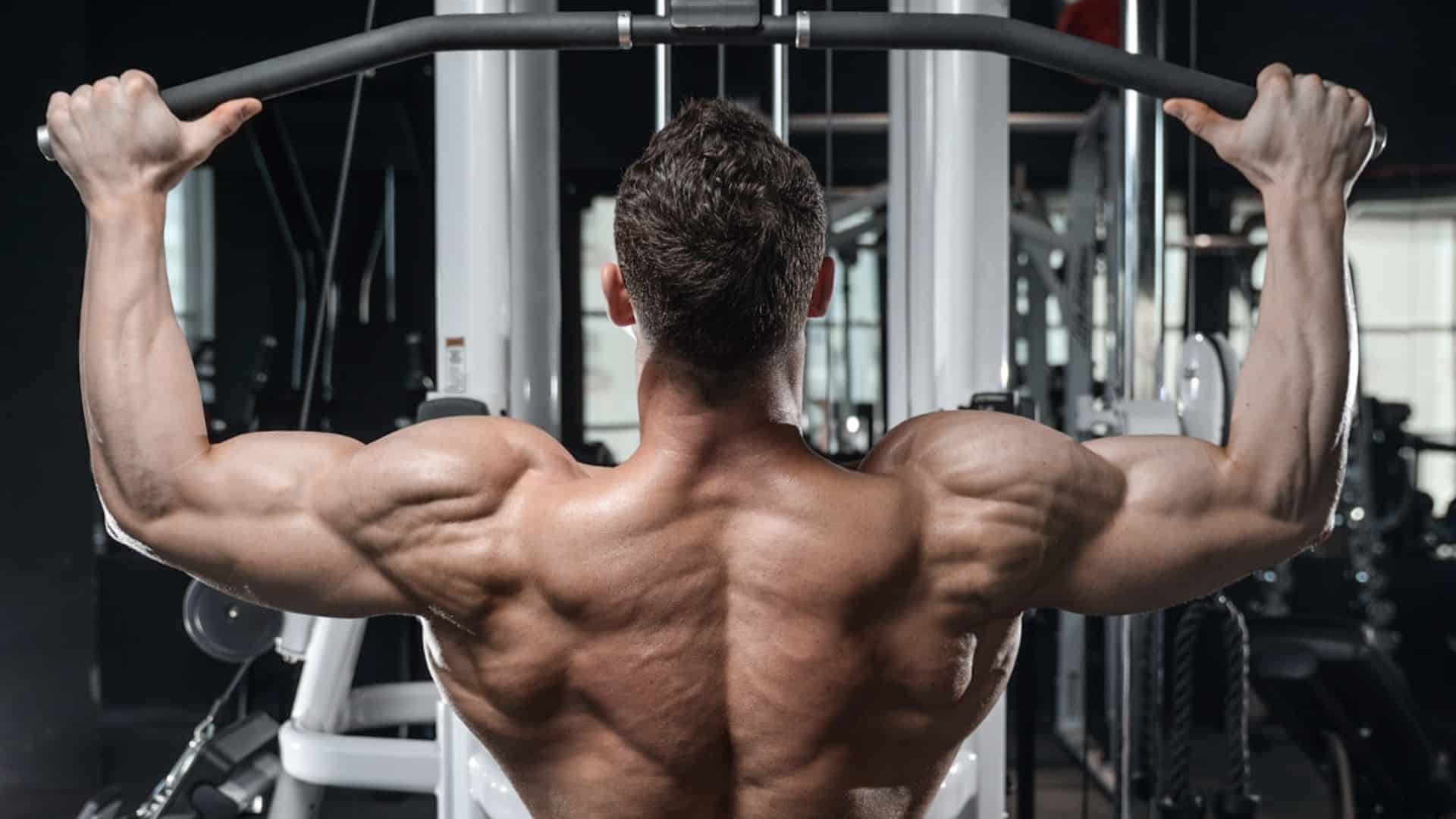
- How to Train Rhomboid Muscles
- 28 Best Rhomboid Exercises for Muscle Mass
- 1. I, Y, T, W
- 2. Inverted Row
- 3. Scapular Push-Ups
- 4. One-arm bench dip
- 5. Bent over Dumbbell Lateral Raise
- 6. Lying Dumbbell Rear Delt Row
- 7. One-Arm Dumbbell Row
- 8. Dumbbell Bent Over Row
- 9. Side-Lying Rear Delt Fly
- 10. Standing Barbell Rear Delt Row
- 11. Barbell Lying Rear Delt Row
- 12. Bent Over Barbell Rows
- 13. T Bar Rows
- 14. Machine Rear Deltoid Fly
- 16. Reverse Cable Crossover
- 17. Face Pull
- 18. Cable High Row
- 19. One-Arm Lat Pulldown
- 20. Seated Cable Rows
- 21. V-Grip Lat Pull Down
- 22. Cable Twisting Standing Row
- 23. Straight Arm Lat Pull Down
- 24. Single Arm Row with Resistance Bands
- 25. Bent Over Rows with Resistance Bands
- 26. Resistance Bands Lats Pulldown
- 27. Seated Row with Resistance Bands
- 28. Resistance Bands Pull Apart
- Workout Plan and Techniques To Train Rhomboid Muscles
- Sets
- Reps
- #1 Rhomboid Workout Plan
- #2 Workout Plan
- #3 Rhomboid Workout Plan
- What is Rhomboid Muscle
- Function of Rhomboid Muscle
- People Also Ask
- 1. What causes weak rhomboids?
- 2. Rhomboid Exercises For Pain
- 3. Rhomboid Exercises For Posture
- 4. Rhomboid exercises for kyphosis
- Takeaway
- References:
How to Train Rhomboid Muscles
Do you know that when you do lat pull down, Row, pull-ups, or any pulling exercise, then you can target your rhomboids? But here’s the thing: Why don’t numerous people target their rhomboids effectively?
Many gym-goers don’t squeeze their shoulder blades at the end of rowing and pull down because they’re working at too high of weight.
Working out your back and shoulders with a lighter weight is much better than exercising your rhomboids.
So, the best way to train your rhomboid is to use lightweight, good form and a full range of motion, which allows you to contact the rhomboid effectively.
Tips: Pull your shoulder blades back and together (scapular retraction), and then squeeze them together. Research has shown that it is the most effective way to train the rhomboid muscles.
28 Best Rhomboid Exercises for Muscle Mass
Let’s get into the best rhomboid strength and hypertrophy exercises using various types of fitness equipment, such as barbells, dumbbells, cable machines, resistance bands, and some bodyweight rhomboid exercises.
We have created the Rhomboid exercises in many sections, such as:
- Bodyweight Exercises at Home (No Equipments).
- Rhomboid Exercises with Dumbbells.
- Barbell & Machine Exercises
- Rhomboid Exercises with Cables.
- Exercises with Resistance band.
1. I, Y, T, W
These exercises focus on the shoulder and back muscles, mainly the middle and lower part of the trapezius.
They also hit all the rotator cuff muscles, including the rhomboid, infraspinatus, subscapularis, teres minor, and supraspinatus muscles.
These work together to stabilize the shoulder and move the arm. These are my favorite exercises to work on the rhomboid muscle.
How to Properly Perform I’s, T’s, and Y’s Exercises
- Lay with your stomach flat on the ground with your arms and legs fully extended.
- Point your toes away from your body and fully extend your elbows and fingers, positioning your palms facing inwards.
- Brace your abdominal muscles to stabilize your spine.
- Depress and retract your scapulae (pull shoulders back and down).
- And attempt to hold these positions (I, Y, T, W) for 5 – 10 seconds.
- Align your head with your thoracic (upper) spine.
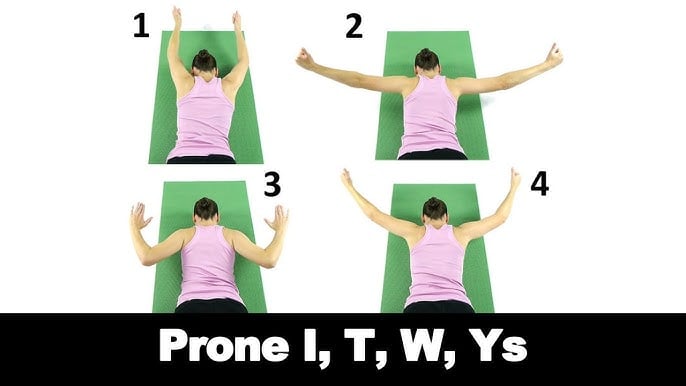
Tips
- Try holding for only five or 10 seconds for the first time, and work up to 30 seconds in future workouts.
- Move your arms slowly up and down in each position of I, T, Y, and W.
- Add a 1-3 pound weight in each hand to increase the difficulty for either version.
2. Inverted Row
The inverted row (bodyweight rows) is one of the best rhomboid exercises. It puts your body horizontally, making it easier to perform.
It also works the back and shoulder muscles from a different angle and improves scapular retraction.
In the gym, most people do this exercise on the Smith machine, but you can also perform it at home by lying under a chair, holding the chair’s sides, and pulling yourself up.

How To Do
- Adjust the height of the chair and bar so that it’s a little higher than arm’s length from the floor.
- Lie under the bar with your legs and body straight.
- Grasp the bar with an overhand grip that’s a little wider than shoulder width.
- Keeping your legs and body straight, exhale as you pull your chest up to the bar.
- Hold for a count of two and squeeze your Rhomboid muscles.
- Inhale as you lower your body until your arms and shoulders are fully extended. Repeat.
Tips
- Do not allow your butt to sag.
- Keeping your elbows at an angle to your body is similar to doing a bench press.
3. Scapular Push-Ups
Scapular push-ups are a variation of regular push-ups that help train rhomboid muscles.
It places greater activity on your rhomboids and serratus anterior muscles than the traditional push-up.
This also results in higher recruitment of your scapular stabilizing muscles (the technical term for the shoulder blades).

How To Do
- Get into a high plank position with your feet hip-width apart and your hands underneath your shoulder-width apart.
- Let your chest drop between your arms so your shoulder blades retract.
- From here, push through the palms of your hands slowly and round through your back to a protracted position.
- You will feel your shoulder blades spread apart.
- Then repeat. Down and up, slowly. Be sure to breathe in on the way down and out on the way up.
Tips
- Use a small range of motion; do not lower your chest all the way to the floor.
- While your body is sinking, Retract and protract your shoulder blades.
- Squeeze your rhomboids with shoulder retraction.
4. One-arm bench dip
The one-arm bench dip is a challenging and very effective movement that primarily targets your triceps, but your glutes and quads, rhomboids, lat also get worked secondarily.

How To Do
- Place your hands (palms) on the side of a flat bench with your back straight, knees bent, and feet flat on the floor.
- Slide your buttocks off the bench. Raise your left arm and right leg straight out in front of you.
- Your body weight should be supported by your right arm and left leg.
- Inhale as you flex your elbow to lower your body until you feel a mild stretch in your shoulder.
- Exhale as you extend your elbow to push your body back up to the starting position.
- Repeat for the desired number of repetitions and repeat the exercise with your left arm.
Tips
- Keep your body upright and your back straight.
- Keep your elbow close to your body, and do not flare out.
- Keep both feet on the floor to make the one-arm bench dip easier.
5. Bent over Dumbbell Lateral Raise
Bent-over raises are an excellent exercise to isolate and work specifically on the rear shoulder head and also train the rhomboid muscle.
This exercise can be performed in both a standing and a seated position. I prefer the seated version as it calls for strict movement.

How To Do
- Sit at the end of a bench with a pair of dumbbells.
- Bend forward and let the dumbbells hang on your sides.
- Lift the dumbbells, raising them on your sides to a level slightly higher than your shoulders.
- Now lower the dumbbells back to your sides.
Tips
- Your arms should be parallel to your shoulders.
- Keep strict form to isolate the rear delts. If done correctly, you will very noticeably feel it in your rhomboids.
6. Lying Dumbbell Rear Delt Row
It is a great basic move. It can effectively target your shoulders, rhomboid, and upper body when done correctly.
The muscles used for dumbbell lying rear delt row may change slightly based on your trained range of motion and technique.

How To Do
- Start off lying on an incline bench with a dumbbell in each hand extended out in front of you.
- Slowly pull the dumbbells up until your elbows are just above your shoulders.
- Once you reach the final position, hold for a count and squeeze your rhomboid muscles.
- Return to the starting position and repeat for as many reps and sets as desired.
Tips
- Keep a controlled motion and avoid jerky movements.
- Really try to focus on your rhomboid muscles as you raise the dumbbell up. Squeeze them and keep your shoulder blades pulled together.
7. One-Arm Dumbbell Row
The one-arm dumbbell row is an excellent full-range exercise to build the lat and rhomboid muscles.
This helps to work on each side independently, thereby providing better muscle isolation and a longer range of motion.
I usually do 10-12 reps on each side in a controlled manner to train my rhomboid and lat effectively.

How To Do
- Grasp a dumbbell with the palm facing in.
- Rest the opposite hand and knee on a bench, keeping your spine straight and just parallel to the floor.
- Pull the dumbbell vertically upward alongside your torso, raising the elbow as high as possible.
- At the end of the row to get that extra bit of contraction in the rhomboids.
- Slowly lower the dumbbell as low as possible, feeling a good lats spread.
- Repeat on the other side.
Tips
- Keep motion under strict control for better isolation.
- Avoid hunchback bending as it leads to Injury.
- Use light dumbbells so you can really focus on squeezing your rhomboid muscles.
8. Dumbbell Bent Over Row
If you want to strengthen the upper back and add massive muscle to the upper back region, then bent-over dumbbell rows are the best exercise.
- Pulling the dumbbell up higher toward the chest targets the upper latissimus and trapezius.
- Pulling the dumbbell through a lower trajectory to touch the abdomen targets the lower lats.

How To Do
- Stand with a narrow stance and a dumbbell with a neutral grip in each hand.
- Bend your torso forward at an angle of 45 degrees to the floor with your knees slightly bent.
- Now, use the back and raise the dumbbell until it touches the abdominal region and not the chest region, as it reduces back muscle contraction.
- Slowly lower the dumbbell, keeping it in control of the starting position.
Tips
- Do not use more weight than you can handle. This fatigues your spinal erectors and says goodbye to form.
- Keep movement always under control without letting gravity take you down faster.
9. Side-Lying Rear Delt Fly
It is a great unilateral exercise used to target a smaller and often lagging muscle group. Instead of lying on the floor, you can lie on a bench.

How To Do
- Lie on the floor on your right side, and grasp the dumbbell with your left hand using a neutral grip (palm facing downward).
- Exhale as you raise the dumbbell from the floor until it is almost vertical. Hold for a count of two.
- Inhale as you reverse the movement and lower the dumbbell towards the starting position.
- Repeat for the desired number of repetitions.
- Repeat the exercise on the opposite side with your right arm.
Tips
- Do not allow the dumbbell to touch the floor.
- Keep the abs braced, and don’t arch the back at the movement’s top.
- Allow the arms to move freely, but don’t lock out the elbows.
10. Standing Barbell Rear Delt Row
Standing barbell rear delt row is a free weight exercise that primarily targets the rear deltoid and middle back, and to a lesser degree, it also targets the biceps, shoulders, and traps.
If you haven’t tried this exercise before, load the barbell with a reasonable amount of weight, prioritizing an amount that allows you to stick to proper form rather than trying to lift heavy.

How To Do
- Stand up straight while holding a barbell using a wide (higher than shoulder width) and overhand (targets rhomboids better than underhand) grip.
- With slightly bent knees, bend over at the waist so that your chest is parallel to the floor.
- While keeping the upper arms perpendicular to the torso, pull the barbell up towards your upper chest as you squeeze the rhomboid.
- Slowly go back to the initial position as you breathe in.
- Repeat 8-10 repetitions.
Tips
- Refrain from using your biceps to do the work.
- Focus on the form before you go for a heavyweight.
- Maintaining the right posture while working out is extremely important.
11. Barbell Lying Rear Delt Row
Barbell Lying Rear Delt Row is a strength exercise that works your side deltoids. When done correctly, it can effectively target your shoulders and upper body.

How To Do
- Lie down on an incline bench with a barbell and hand extended out in front of you.
- Slowly pull the barbell up until your elbows are just above your shoulders.
- Once you reach the final position, hold for a count and squeeze your rhomboid muscles.
- Return to the starting position and repeat for as many reps and sets as desired.
Tips
- Remember to exhale while you exert.
- The form is a very important part of this exercise.
- Don’t just swing your arms. Keep controlled motion throughout the exercise.
12. Bent Over Barbell Rows
The bent-over barbell row is a compound exercise that strengthens the back. It also engages other muscles like the biceps, lower back, and core to a lesser extent.
The rhomboids are responsible for squeezing the shoulder blades together and pulling them down and back.

How To Do
- Stand with your feet shoulder-width apart and the barbell on the floor in front of you.
- Bend at your hips and knees to grab the barbell with an overhand grip, hands slightly wider than shoulder-width apart.
- Keep your back straight and your core engaged.
- Your head should align with your spine, and your eyes should look down at the floor.
- Exhale and row the barbell up towards your chest, using your elbows and upper back muscles.
- Pause at the top of the movement and squeeze your shoulder blades together.
- Slowly lower the bar under control to the starting position.
Tips
- Do not use more weight than you can handle. This fatigues your spinal erectors and says goodbye to form.
- When doing rows, focus on really squeezing your rhomboids.
13. T Bar Rows
T bar Rows are a power exercise to build middle back muscles. It is done on a T-bar machine or placing a barbell in the corner.
It is tough exercise, but building a strong back is a must to develop a quality physique and stay injury- and pain-free for life.

How To Do
- Standing on a T-bar machine, grab its handles with an overhand grip.
- Keep your feet a bit apart and knees slightly bent.
- Bend at the hips and keep your back arched throughout the movement.
- Lift the bar until the bar touches your chest, keeping the back straight.
- Now, slowly lower the bar until it nearly touches the ground.
Tips
- Avoid hunchback bending as it leads to Injury.
- Make sure you use a weight that allows you to have a full range of motion.
- You won’t be able to target your rhomboids effectively without a full range.
14. Machine Rear Deltoid Fly
The machine rear delt fly, or reverse pec deck fly, is a simple yet effective exercise that increases deltoid and back muscle definition and strength.
The pec deck rear delt machine fly targets your upper back muscles and shoulder muscles, particularly the rear deltoids (backside of your shoulders), Traps, and rhomboids.

How To Do
- Sit facing the rear deltoid machine with your chest against the backrest.
- Grasp the handles directly in front of arms outstretched at shoulder level.
- Pull the handles back in an arc as far as possible.
- Keep your elbows high and your arms parallel to the floor.
- Return the handles to the start position directly in front.
Tips
- Try not to move anything but your shoulders.
- Remember to exhale while you exert.
16. Reverse Cable Crossover
During reverse cable crossover, your arms should move directly back (and downward slightly) almost parallel to the floor to target the posterior deltoid.
If the hands are raised through a higher arc to a point above shoulder level, the trapezius, rhomboids, and lateral deltoids make a bigger contribution to the movement.
Crossing your hands over one another (uncrossing the cables) at the start position increases the range of motion.

How To Do
- Stand in the center of a cable crossover apparatus.
- Start with hands crossed in front of you at shoulder height, with the left high cable in your right hand and the right in your left hand.
- Pull your elbows out and back as far as possible using your rear delts.
- Then, slowly return to the starting position.
- Do 8-12 Reps of 3-4 sets
Tips
- The posterior deltoid is best targeted with your torso upright, not leaning too far forward or back.
- Keep a controlled motion and avoid jerky movements.
17. Face Pull
Face pull is a cable machine exercise that primarily targets the rear deltoid and, to a lesser degree, also targets the rhomboid, biceps, triceps, and traps.
Use a cable pulley machine to pull the weight straight toward your forehead. This exercise prevents muscular imbalance and builds overall shoulder strength.
It is one of my favorite exercises that I use to train and build strong rhomboid muscles after a back workout.

How To Do
- Grab the ends of the rope attachment using a neutral grip (palms facing each other) and slightly lean back.
- Pull the rope toward your face as you spread the ends of the rope so they end up on the sides of your ears just above your shoulders in the finish position.
- Hold this position for a second as you squeeze your shoulder blades together.
- Then, slowly return the rope to the start position and repeat for reps.
Tips
- Be sure to exhale when pulling weight toward your face.
- Think about trying to pinch your shoulder blades as tight as possible when pulling weight toward your face.
- Go light with this exercise, as that will reduce the focus on the shoulders.
18. Cable High Row
High cable row is a wonderful exercise that effectively works many muscles, including the shoulder, back, wing, and trapezius muscles.
Using this exercise gives people with shoulder issues an exercise to get the benefits of rows.
In addition, face pull is one of the most effective corrective exercises that help compensate for poor posture and shoulder dysfunction.

How To Do
- Set the cable up at a high point with the rope attachments
- Grab the rope with both hands using an overhand grip, then take a step back and get onto your knees facing the cable machine
- Starting with your arms stretched out and away, pull back through your elbows until your hands are just in front of your shoulders
- Slowly return to the starting position. Repeat for desired reps.
Tips
- Don’t lean backward to pull the weight towards you.
- Focus on the mind-muscle connection to pull down by using your rhomboid muscles.
19. One-Arm Lat Pulldown
One study has showed that performing a pulling exercise with the arms raised above the head is more effective in selectively strengthening the rhomboid muscle.
The lat pulldown is an exercise used to build the back muscles. It is a great exercise for the back that is widely used by fitness trainers to build bigger lats.
This isolating exercise focuses on the back muscles without tiring the biceps.
Targeting your back muscles is important to help with proper posture and ease pulling movements.

How To Do
- Take an overhand grip, hands slightly wider than shoulder-width apart, and sit on the machine seat. Lock your knees under the support pads.
- Keep your upper back straight, pull the bar down, and bring it to your chest.
- As you pull down, squeeze your shoulder blades together and feel your back muscles contracting.
- Perform this movement using your upper lats and use the arms merely as a lever between the bar and the lats.
- Now, release the bar with controlled motion and stretch your lats as much as possible.
Tips
- Your reps should be slow and controlled to make the most of this move.
- Go full range of motion and concentrate on your rhomboid and upper back muscles doing the major work.
20. Seated Cable Rows
Seated Cable Rows are an excellent exercise to build middle back muscles, which also works on lower lats. It can be done with wide and narrow grips.
Squeezing shoulder blades together is the most effective way to exercise the rhomboid muscles.

How To Do
- Sit on a seated cable pulley rowing machine with legs slightly bent and feet supported against the crossbar.
- Take hold of the handles with your arms extended and back stretched.
- Pull the handles to come as close to the lower chest/abdomen as possible.
- Thrust your chest out while pulling with your body in an upright position.
- Slowly return the handle to the starting position.
Tips
- Pause briefly when the handles are close to the chest and squeeze your rhomboid muscles, bringing the scapulae closer.
- Keep your knees slightly bent to avoid knee and lower back pressure.
- Remember, a rounded back is a wrong back. Keep it straight at all times.
- Keep your upper back stationary; don’t move back and forth.
21. V-Grip Lat Pull Down
The V grip lat pulldown primarily targets the lats; you will also notice a fair amount of bicep and middle back activation.
The back is a muscle group that requires a fair amount of variation. So, experiment with several different angles and hand positions to maximize your back muscle growth.
it is This is the perfect exercise to add to your rhomboid workout collection.

How To Do
- Attach a V handle to the high pulley of a lat-pulldown station.
- Grab the handles with your palms facing each other and position yourself on the seat with your knees under the pads.
- Keep your upper back straight, pull the V handle down, and bring it up to the chest.
- As you pull down, squeeze your shoulder blades together and feel your back muscles contracting.
- Perform this movement using your upper lats and use the arms merely as a lever between the handle and lats.
- Now, release the bar with controlled motion and stretch your rhomboids as much as possible.
Tips
- Avoid using a heavyweight.
- Go full range of motion and concentrate on your back muscles doing the major work.
22. Cable Twisting Standing Row
The cable back exercise involves numerous muscles requiring you to rotate slightly at the waist. Because this is a unilateral exercise, you must engage your core throughout the movement.
Besides being a great back exercise, this movement also works your hips, glutes, and other lower body muscles.
I enjoy this exercise because I feel that my rhomboid is completely trained after doing it.
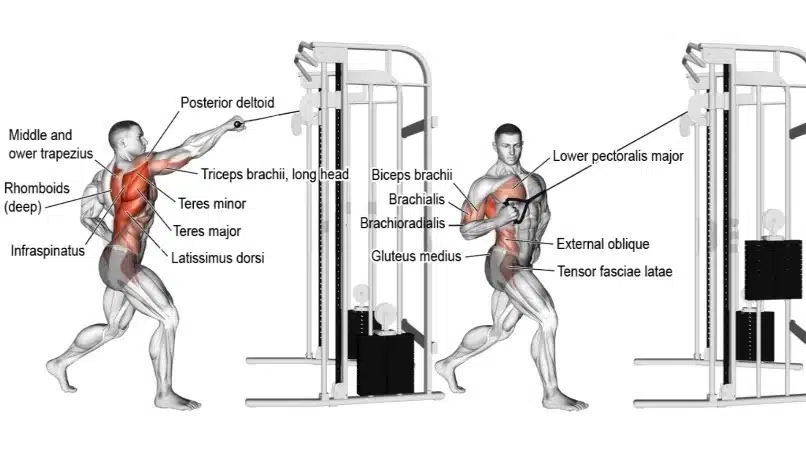
How To Do
- Attach a single grip handle to an elbow-high cable pulley.
- Step back and get into a staggered stance, knees slightly bent.
- Your arm should be out straight, and your waist should be rotated towards the cable.
- Keeping your elbow close to your body, pull back towards your waist while rotating your waist in the same direction.
- Pause briefly at the movement’s top, then slowly return to the starting position. Repeat desired reps.
Tips
- Make sure the rotation is in your waist, not your hips.
- You can place your inactive hand on your other hip for added stability.
- Your reps should be slow and controlled to make the most of this move.
- This rotation allows you to target your rhomboids better and really squeeze them.
23. Straight Arm Lat Pull Down
While the exercise will primarily target the lats, you will also notice a fair amount of bicep and middle back activation.
This isolation exercise can also help to improve your posture.

How To Do
- Take an overhand grip that is wider than shoulder-width on a lat bar attached to the pulley on the lat pulldown bar.
- Position yourself with your feet flat on the floor, chest up, and low-back arch exaggerated.
- Pull your shoulder blades together as you squeeze your rhomboid.
- Hold the contraction for a moment, then slowly return the bar all the way back to the starting position.
Tips
- Don’t allow the head to jut forward as you pull.
- Keep your elbows slightly flexed and your body still.
24. Single Arm Row with Resistance Bands
The primary mover here is the latissimus dorsi. So, that is the main muscle you are targeting. However, you will also be engaging your entire back with this one, which includes your trapezius, rhomboids, & deltoids.
Moreover, as it is a single-arm movement, your core and lower back will be working to stabilize you.
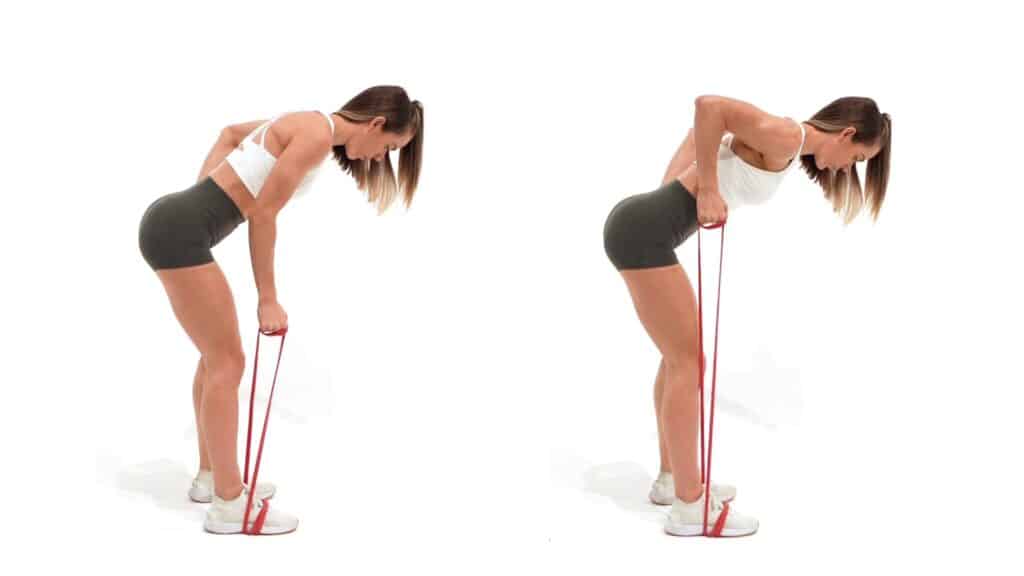
How To Do
- Place the center of a resistance band under your right foot and stand with your feet staggered, left behind right.
- Hold the ends of the band in your right hand next to your leg and bend forward from the hips.
- Brace your core and drive your right elbow past your back until the band is fully taut.
- Reverse direction and perform the prescribed number of repetitions before switching sides.
Tips
- Concentrate on pulling with your back muscle right behind and below your shoulder (lats).
- Pull your shoulder down and back to set and stabilize your shoulder blades.
25. Bent Over Rows with Resistance Bands
Bent over rows are one of the best back exercises you can do as they target many muscles simultaneously.
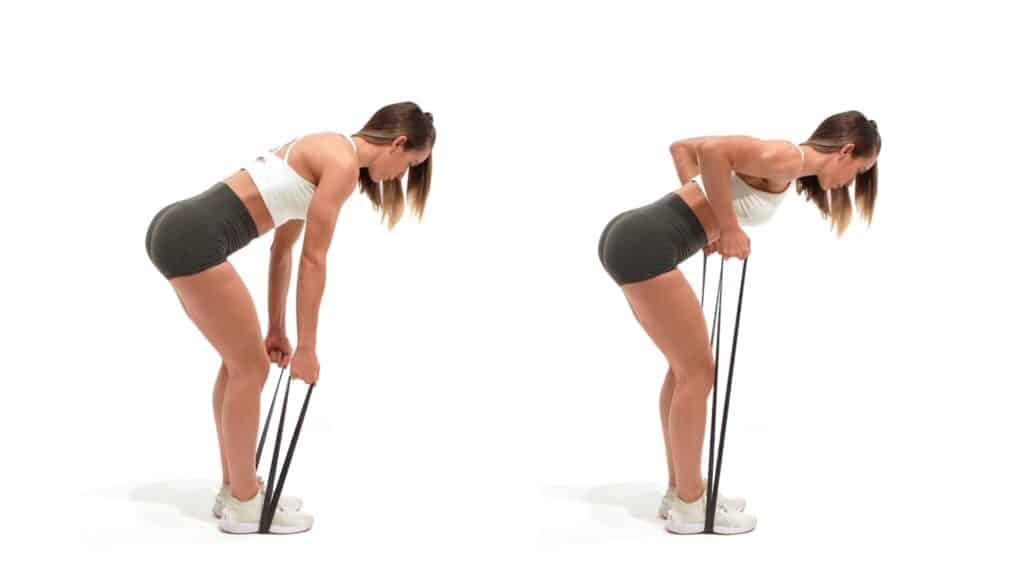
How To Do
- Stand on a resistance band, bending forward slightly, and hold both handles just under your knee.
- Keep your back flat and arms straight.
- Leading with your elbows, pull the handles of the resistance band back.
- Hold this contraction and slowly release it to the starting position.
Tips
- Make sure you maintain the high hip hinge as you row. Keep your core engaged.
- Maintain alignment at all times. Protract your shoulder blades at the bottom.
26. Resistance Bands Lats Pulldown
The resistance band lats pulldown can be done anywhere, so it’s a good option for home workouts or while traveling.
It is a compound exercise that engages multiple muscle groups of the back, specifically the latissimus dorsi (lats) and teres major.

How To Do
- Attach the resistance band to a sturdy anchor point above your head, such as a door frame.
- Stand facing the anchor point and grasp the resistance band with an overhand grip.
- Step back to create tension in the band. Engage your core, and lean back slightly.
- Pull the band down towards your chest. Squeeze your shoulder blades together at the end of the movement.
- Slowly release the tension and return to the starting position.
Tips
- Focus on your rhomboids, squeeze them on the way down, and keep them tight and contracted on the way back up.
- Be sure to retract your shoulder blades as you pull down. Squeeze them together.
27. Seated Row with Resistance Bands
The seated row with resistance bands targets the traps (lower), latissimus dorsi, rhomboids, rear delts, and biceps.
It will also work your erector spinae, as you need your lower back to stabilize your movement. Overall, this is a great movement for your mid-back.
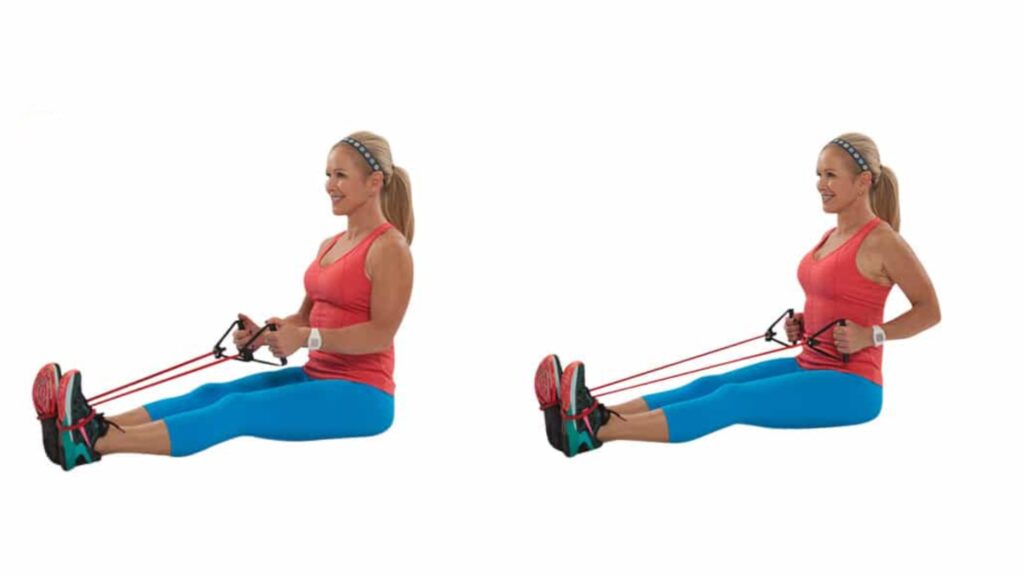
How To Do
- Sit on the floor with your legs extended, loop the resistance band around the soles of your feet, and hold one end in each hand.
- Keep your posture erect and your lower back slightly arched.
- Keep your elbows close to your sides and slowly pull the handles to your lower abdomen,
- As the handles touch your body, squeeze your shoulder blades together.
- Then, reverse direction and slowly return to the start position.
Tips
- Retract your shoulder blades as you pull the band back.
- Maintain your legs extended with just a slight bend in the knee, and keep your shoulders back.
28. Resistance Bands Pull Apart
This movement can be done on shoulder day, as it targets the rear delts. However, we also like to hit it on a back day as the rear delts often need to double the weekly work.
The reverse fly with bands will work your rhomboids, rear delts, and traps. It’s a great upper-back exercise.
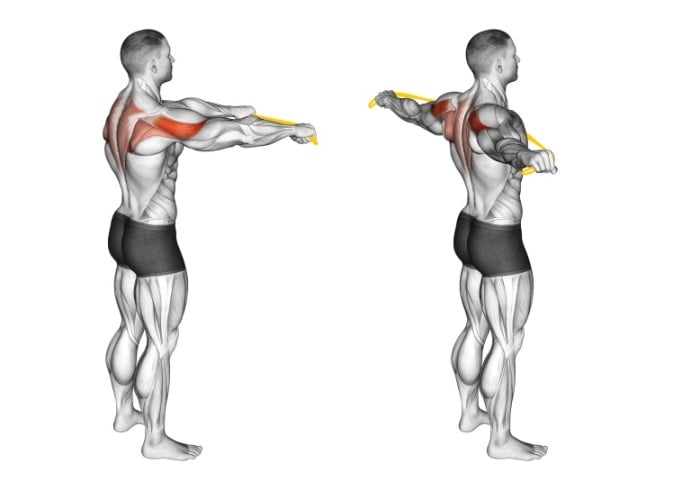
How To Do
- Stand with your feet shoulder-width apart, keeping a slight knee bend.
- Hold the exercise band before you with your hands slightly lower than your shoulders.
- Keep your elbows slightly soft to avoid hyperextending the joint.
- pulling the band apart and squeezing the shoulder blades together to open the arms out to either side.
- Return to start and repeat, keeping tension on the band the entire time.
Tips
- Focus on really contracting your upper back muscles.
- Squeeze and hold once you reach the peak contraction, then slowly return to the starting position.
- Keep your core engaged throughout each set.
- Try to keep your elbows up so you can target your upper back muscles correctly.
Workout Plan and Techniques To Train Rhomboid Muscles
Of course, the number of sets and reps will be determined based on your fitness journey, but here is a great starting point:
Sets
According to the latest scientific evidence, 12–20 weekly sets per muscle group may optimize muscle growth.
- Beginners: ~10 sets per week.
- Intermediate: ~15 sets per week.
- Advanced: ~20 sets per week.
Reps
The best rep ranges and loads to work with.
- For muscle endurance: Aim for 15-20+ reps with moderate resistance.
- For muscle strength: 6-10 reps, with more resistance.
- For muscle hypertrophy (increased muscle size): Aim for 3-4 sets of 8-12 reps, with a moderate to heavy amount of resistance.
It is always best to start with fewer reps and sets and then gradually increase as your strength improves.
#1 Rhomboid Workout Plan
| Exercises | Sets | Reps |
|---|---|---|
| I, Y, T, W | 4 | 12-15 |
| Bent Over Raise | 4 | 8-12 |
| Barbell Rows | 3 | 8-10 |
#2 Workout Plan
| Exercises | Sets | Reps |
|---|---|---|
| Inverted Row | 4 | 8-12 |
| Barbell Rear Delt Row | 4 | 6-8 |
| Reverse Cable Crossover | 3 | 8-12 |
| Dumbbell Rear Delt Row: | 4 | 10-15 |
#3 Rhomboid Workout Plan
| Exercises | Sets | Reps |
|---|---|---|
| Scapular Push-Ups | 4 | 8-12 |
| One Arm Row | 4 | 8-10 |
| Lying Rear Delt Row: | 3 | 8-12 |
| Face Pull | 4 | 10-12 |
What is Rhomboid Muscle
The rhomboids comprise two muscles, the rhomboid minor and the larger rhomboid major.
The rhomboids are rhombus-shaped and are used to pull the shoulder blades together.
The rhomboid muscles are located on your upper back underneath the trapezius muscle. These muscles diagonally connect your spine (cervical and thoracic vertebrae) to your shoulder blades (scapulas).
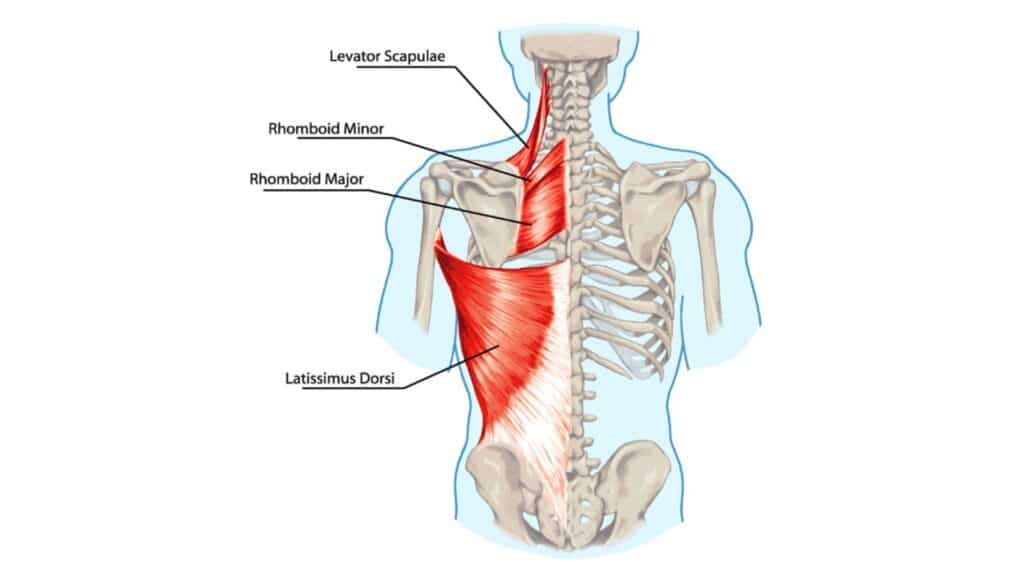
The Rhomboid Major is thin and flat and twice as wide as the thicker Rhomboid Minor, which lies superior to it.
Although they sit pretty high up on the back, they are usually considered a “mid-back” exercise because that is where you will feel them when doing exercises that target the rhomboids.
Rhomboids are superficial muscles, meaning they are close to the skin’s surface. However, they lie deep in the trapezius muscle of the upper back, and they are dominated by the almighty latissimus dorsi (lats) on the sides.
So, seeing the rhomboids is almost impossible unless you look at a well-defined individual with low body fat.
Function of Rhomboid Muscle
- Adduct the scapula: That means pulling them toward each other. If you can imagine attempting to hold a pencil between your shoulder blades, you can know scapular adduction and feel your Rhomboids contracting.
- Downward rotate the scapula: You get a feel for the downward rotation of the scapula on a typical lat pulldown. As you pull the bar down, the inferior angle of the scapula rotates from out by your armpit back towards the spine.
- Another important function of the Rhomboids (along with the serratus anterior and the pectorals minor) is keeping your scapula against the rib cage.
People Also Ask
1. What causes weak rhomboids?
Rhomboid issues can be caused by
- Incorrect or poor posture
- Extended periods of sitting
- Overhead activities such as reaching for high shelves and
- Carrying heavy backpacks (especially over just one shoulder)
2. Rhomboid Exercises For Pain
Poor posture, such as slouching, can lead to problems like chronic back, neck, and shoulder pain. It can also cause muscle atrophy and weakness.
These rhomboid exercises can help you strengthen the muscles in your back, leading to better posture and less pain as you get older.
Start with bodyweight and resistance band rhomboid exercises, and then gradually start dumbbell, cable, and barbell exercises to strengthen the rhomboid muscle.
3. Rhomboid Exercises For Posture
Do you slouch and experience pain in your upper back? This could be caused by a weakness or an imbalance in your Rhomboids. Your rhomboid muscle is located in the upper back.
This muscle connects the shoulder blades to your rib cage and your spine. This muscle is a key component to having good posture.
Rhomboid exercises will help you stabilize your mid back and strengthen your rhomboids.
Bodyweight Rhomboid exercises
- I, Y, T, W
- Inverted Row
- Scapular Push-Ups.
Dumbbell Rhomboid exercises
- Bent over Dumbbell Lateral Raise
- Lying Dumbbell Rear Delt Row
- Bent Over Row.
Resistance Band
- Single Arm Row with Resistance Bands
- Lat Pulls With Resistance Bands
- Standing Reverse Fly with Resistance Bands
4. Rhomboid exercises for kyphosis
Kyphosis, also known as round back or hunchback, is a condition in which the spine in the upper back has an excessive curvature.
The spine naturally curves in the neck, upper back, and lower back to help absorb shock and support the head’s weight. Kyphosis occurs when this natural arch is larger than normal.
Other potential causes of kyphosis include:
- Aging, especially if you have poor posture
- muscle weakness in the upper back
- arthritis or other bone degeneration diseases
- osteoporosis, or the loss of bone strength due to age
Rhomboid kyphosis exercises help train your upper back and strengthen the muscles, increase bone density, and improve posture.
Takeaway
Rhomboid exercises are highly recommended for anyone interested in strengthening back muscles, learning to contract your shoulder blades, and improving posture.
There’s a sense of command, confidence, and less stress on your back when you have perfect posture.
Retracting and contracting your shoulder blades will improve your squats, chest presses, and pull-ups.
More importantly, the more you strengthen your back, the less prone to injury you’ll be when it comes to working out or working at your desk.
References:
- Fennell J, Phadke CP, Mochizuki G, Ismail F, Boulias C. Shoulder Retractor Strengthening Exercise to Minimize Rhomboid Muscle Activity and Subacromial Impingement. Physiother Can. 2016;68(1):24-8. doi: 10.3138/ptc.2014-83. PMID: 27504044; PMCID: PMC4961314.
- Fennell J, Phadke CP, Mochizuki G, Ismail F, Boulias C. Shoulder Retractor Strengthening Exercise to Minimize Rhomboid Muscle Activity and Subacromial Impingement. Physiother Can. 2016;68(1):24-8. doi: 10.3138/ptc.2014-83. PMID: 27504044; PMCID: PMC4961314.
- Yoo WG. Effects of pulling direction on upper trapezius and rhomboid muscle activity. J Phys Ther Sci. 2017 Jun;29(6):1043-1044. doi: 10.1589/jpts.29.1043. Epub 2017 Jun 7. PMID: 28626320; PMCID: PMC5468195.
- Smith J, Padgett DJ, Kaufman KR, Harrington SP, An KN, Irby SE. Rhomboid muscle electromyography activity during 3 different manual muscle tests. Arch Phys Med Rehabil. 2004 Jun;85(6):987-92. doi: 10.1016/s0003-9993(03)00618-x. PMID: 15179655.
- Farrell C, Kiel J. Anatomy, Back, Rhomboid Muscles. StatPearls [Internet]. 2021 Jul 26.
- http://brentbrookbush.com/rhomboids/

Manish brings over 10 years of hands-on experience in weight lifting and fat loss to fitness coaching. He specializes in gym-based training and has a lot of knowledge about exercise, lifting technique, biomechanics, and more.
Through “Fit Life Regime,” he generously shares the insights he’s gained over a decade in the field. His goal is to equip others with the knowledge to start their own fitness journey.
